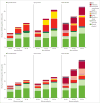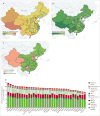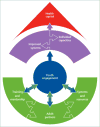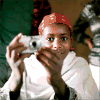Our future: a Lancet commission on adolescent health and wellbeing
- PMID: 27174304
- PMCID: PMC5832967
- DOI: 10.1016/S0140-6736(16)00579-1
Our future: a Lancet commission on adolescent health and wellbeing
Conflict of interest statement
All authors declare that the work of the Commission on Adolescent Health and Wellbeing was supported by the Bill & Melinda Gates Foundation (Seattle, WA, USA), MacArthur Foundation (Chicago, IL, USA), Australia India Institute (Melbourne, VIC, Australia), and the Murdoch Childrens Research Institute (Melbourne, VIC, Australia). The funding covered travel, accommodation, and meals for the Commission meetings, as well as development of background papers, project management and research assistant time. 12 authors reported grants from either the Bill & Melinda Gates Foundation, MacArthur Foundation, or the University of Melbourne, during the conduct of the study. RA received personal fees from UNDP, outside the submitted work. SMS is a member of WHO’s Technical Advisory Committee for the Department of Maternal, Newborn, Child and Adolescent Health.
Figures



















Comment in
-
From Advocacy to Action in Global Adolescent Health.J Adolesc Health. 2016 Oct;59(4):375-7. doi: 10.1016/j.jadohealth.2016.08.002. J Adolesc Health. 2016. PMID: 27664465
-
Involving adolescents in the discussion about SDGs.Lancet. 2017 May 20;389(10083):1979. doi: 10.1016/S0140-6736(17)31318-1. Lancet. 2017. PMID: 28534748 No abstract available.
-
Adolescent health and wellbeing: advocating a role for urban design.Lancet Child Adolesc Health. 2018 Oct;2(10):697-699. doi: 10.1016/S2352-4642(18)30253-0. Lancet Child Adolesc Health. 2018. PMID: 30236374 No abstract available.
Similar articles
-
The Grand Divergence in Global Child Health: Confronting Data Requirements in Areas of Conflict and Chronic Political Instability.JAMA Pediatr. 2016 Mar;170(3):195-7. doi: 10.1001/jamapediatrics.2015.4275. JAMA Pediatr. 2016. PMID: 26809944 No abstract available.
-
Gender relations, sexual behaviour, and risk of contracting sexually transmitted infections among women in union in Uganda.BMC Public Health. 2016 May 26;16:440. doi: 10.1186/s12889-016-3103-0. BMC Public Health. 2016. PMID: 27229928 Free PMC article.
-
Young People's Sexual and Reproductive Health Interventions in Developing Countries: Making the Investments Count.J Adolesc Health. 2016 Sep;59(3 Suppl):S1-3. doi: 10.1016/j.jadohealth.2016.06.016. J Adolesc Health. 2016. PMID: 27562448 No abstract available.
-
Sexually transmitted infections among adolescents: the need for adequate health services.Reprod Health Matters. 2001 May;9(17):170-83. doi: 10.1016/s0968-8080(01)90021-7. Reprod Health Matters. 2001. PMID: 11468834 Review.
-
Addressing intimate partner violence and sexual violence among adolescents: emerging evidence of effectiveness.J Adolesc Health. 2015 Jan;56(1 Suppl):S42-50. doi: 10.1016/j.jadohealth.2014.08.012. J Adolesc Health. 2015. PMID: 25528978 Review.
Cited by
-
Association between stressful life events and depression, anxiety, and quality of life among urban adolescents and young adults in Latin America.Front Psychol. 2024 Nov 7;15:1466378. doi: 10.3389/fpsyg.2024.1466378. eCollection 2024. Front Psychol. 2024. PMID: 39575343 Free PMC article.
-
DYnamics of Contraception in Eswatini (DYCE): protocol for a high-frequency, longitudinal cell phone survey.BMJ Open. 2024 Nov 14;14(11):e090686. doi: 10.1136/bmjopen-2024-090686. BMJ Open. 2024. PMID: 39542494 Free PMC article.
-
Parental obesity, health determinants, and cardiometabolic risk according to sleep duration in schoolchildren: analysis through structural equations.Ital J Pediatr. 2024 Nov 9;50(1):241. doi: 10.1186/s13052-024-01800-z. Ital J Pediatr. 2024. PMID: 39522030 Free PMC article.
-
Contradictions and possibilities for change: Exploring stakeholder perspectives of Canada's Feminist International Assistance Policy (FIAP) and their connection to a future for global health.PLOS Glob Public Health. 2024 Nov 8;4(11):e0003877. doi: 10.1371/journal.pgph.0003877. eCollection 2024. PLOS Glob Public Health. 2024. PMID: 39514473 Free PMC article.
-
Association of physical activity, screen time and sleep with substance use in children and adolescents: a large sample cross-sectional study.Front Public Health. 2024 Oct 17;12:1432710. doi: 10.3389/fpubh.2024.1432710. eCollection 2024. Front Public Health. 2024. PMID: 39484350 Free PMC article.
References
-
- Lamy P, Bachelet M, Barber L, et al. Now for the long term: the report of the Oxford Martin commission for future generations. Oxford: Oxford Martin School; 2013.
-
- Whitmee S, Haines A, Beyrer C, et al. The Rockefeller Foundation–Lancet Commission on planetary health. Safeguarding human health in the Anthropocene epoch: report of The Rockefeller Foundation–Lancet Commission on planetary health. Lancet. 2015;386:1973–2028. - PubMed
-
- Blakemore SJ, Mills KL. Is adolescence a sensitive period for sociocultural processing? Annu Rev Psychol. 2014;65:187–207. - PubMed
-
- United Nations Secretary-General. The global strategy for women’s, children’s and adolescentss health (2016–2030): survive thrive transform. 2015 http://www.who.int/life-course/partners/global-strategy/globalstrategyre... (accessed April 3, 2016)
-
- UN. Transforming our world: the 2030 agenda for sustainable development. New York: United Nations; 2015.
Publication types
MeSH terms
Grants and funding
LinkOut - more resources
Full Text Sources
Other Literature Sources
Medical


